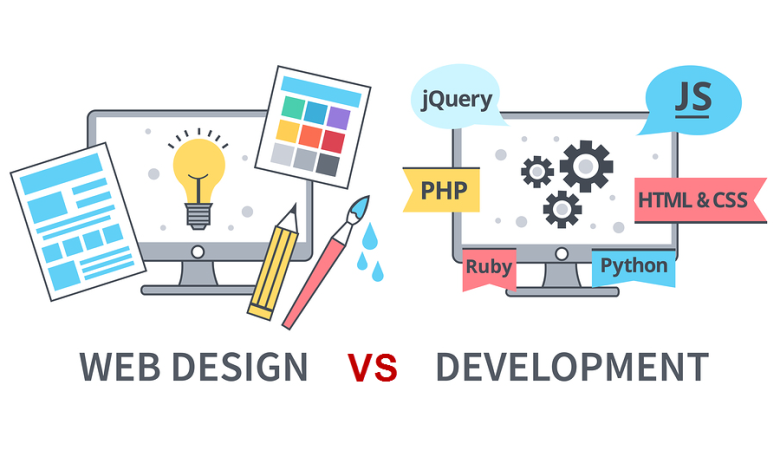Web Design & Development Company!

Web design and development are terms that can be used interchangeably. Almost every web design and digital marketing firm claim to provide both services. Most of them can deliver other project elements for a client, either in-house or through partnerships.
It’s essential to understand the distinction between design and development when looking for web design or web development firms to work with. Depending on your objectives, you may only require design or development, or both.
After reading this, you’ll know what to look for in a good web design or web development company and how to choose the right developers and designers to make you a professional website.
How to select the right web design and development company for your project?
To select the right web design and development services, go through the points below –
1. A track record of success
Before hiring designers, developers, or an agency, you should look at their portfolios to see what they can do for you. If an example isn’t available on their website, ask for one (not every company wants to broadcast this due to the risk of competitors stealing clients).
Agencies and developers/designers who have worked with similar companies, as well as a mix of B2B and B2C experience, are positive signs. It’s also a good idea to check out their websites on mobile devices to make sure they’re up to date on industry trends and events. You can also look at their employees’ portfolios on Behance or Github if they have any.
2. Inexpensive
Designers and developers should set a price that appears to be “just right.” Prices that appear to be too low usually indicate that work will be rushed or that you will end up with a low-quality or template-designed website that will not achieve your goals. It may even be necessary to hire a different company or team to rebuild it.
Avoid working with designers and developers who appear to be getting a good deal. At the same time, if a quote seems to be excessive, walking away is a better option than going over budget.
Consider hiring before hiring a design or development team. Geographic factors influence three types of hiring solutions: local talent, nearshore programmers, and offshore developers/dev teams.
Then decide what type of work you want to do. Would you like to hire a dedicated team with a project manager or Scrum master, a freelancer through Upwork/Toptal, or staff augmentation through companies like Owebest Technologies?
Keep in mind that, depending on the country you want to outsource to and the hiring model you choose, there could be a significant wage difference.
3. Design Abilities
Make sure you’ve seen examples of their work before working with any designer. It will provide you with an idea of what they can do for your website and allow you to discuss your ideas with them. Ideally, they should come up with a few ideas for this during the costing process. During the discovery phase, a designer may create a stylized mockup, giving you the option to choose the overall design you want them to create.
4. Coding expertise
Similarly, you must ensure that the developer or team responsible for your website’s back-end has the necessary coding skills and knowledge. You can also see examples of similar websites built with the same languages and technology stack. Verifying a developer’s hard skills is also important. You can begin the interview by inquiring about their previous employment. Then, ask pertinent questions about the programming language on which your website will be built. Make sure to assign a coding task; it can be real-time coding or a task with a deadline.
5. Reliable customer service
Creating and developing a website is a collaborative effort. And, throughout this process, you must have faith in the company or team doing the work. A lack of or infrequent communication is a red flag. Ensure that those doing the work are responsive and that any feedback and changes you want to make are taken into account.
A few factors can have an impact on your communication. Did you opt for offshore outsourcing? To avoid project delays, make sure your time zones are at least 3 hours apart. Decide on a communication channel and assign responsibilities before the project begins. Do you have a tech person on your team, such as a CTO, who will oversee project delivery? Who will be in charge of communication from the service provider’s end? Did you set any goals?
Web Developers with certificates demonstrating their skills are valuable assets. Certification and accreditation can assist companies with in-house talent in completing more complex projects. Certificates from industry leaders like Google, Adobe, Rackspace, and Amazon Web Services are worth looking for and asking about.
7. Positive feedback
As with any purchase, make certain that you work with professionals who have received positive feedback and customer testimonials. If they are unwilling to meet with you, request a couple of clients you can email for a reference. Don’t be afraid to contact previous clients and inquire about project delivery, quality, and issues. You can read reviews of top web design companies on Clutch.co, Glassdoor, and G2.
8. Timetable
Service providers must adhere to agreed-upon timelines. Typically, an agency will quote a project based on the overall work rather than how many hours a team works on a website. Otherwise, projects may take longer than expected, resulting in increased costs.
When building a website, hire a developer and decide whether you want a custom-coded or template website. Knowing this should help you decide whether you need a website designer or a team that can do both. Please make sure they know what’s going on in the industry, have a portfolio and client recommendations, charge a fair price, and can get the job done on time.
Read more – Understanding the Basics of Web Development Process




